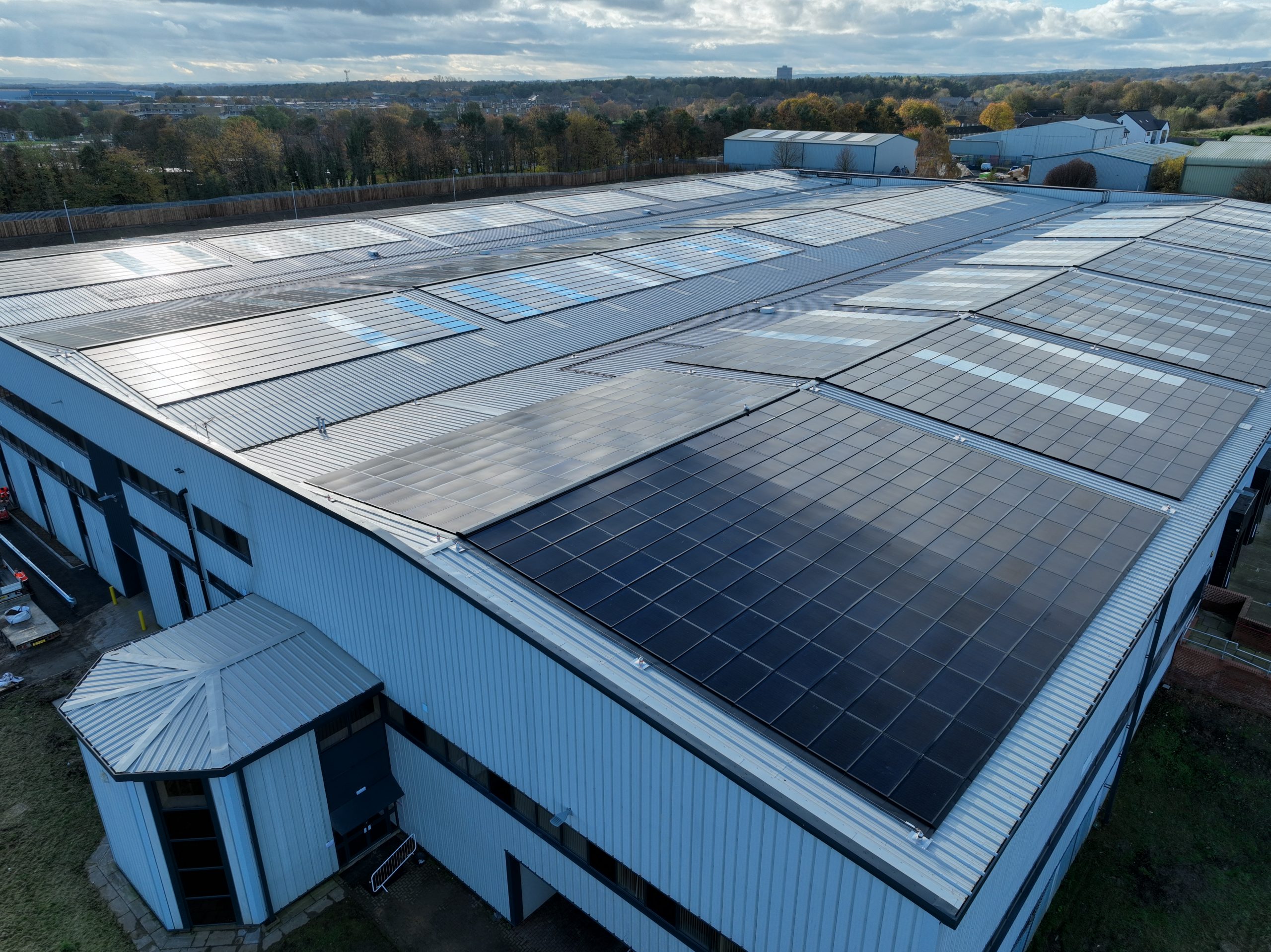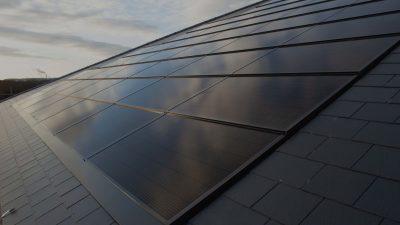In the current dynamic energy landscape, integrated solar panels are emerging as a key innovation, seamlessly blending aesthetics with functionality. These advanced panels are designed to be incorporated directly into the architecture of buildings, rather than being added on as an afterthought.
This integration not only enhances the visual appeal of structures but also maximizes the efficiency of solar energy capture. As more businesses and homeowners seek sustainable energy solutions, integrated solar panels offer a smart and sophisticated choice for modern energy management.

Understanding Integrated Solar Panels
Integrated solar panels are a sleek, modern innovation that differentiates themselves from traditional solar panels by being incorporated directly into the building structure rather than mounted on top.
These solar solutions, including in-roof solar panels, merge seamlessly with the roofline, providing a dual function of energy generation and weather protection. The components of an integrated solar panel system include the photovoltaic cells, wiring, inverter, and a mounting system that also serves as part of the roof structure.
This integration streamlines the solar array’s profile and potentially increases its efficiency by reducing heat buildup underneath the panels. By transforming sunlight into electricity at the point of capture, integrated solar panels exemplify a leap forward in architectural design and energy management, unlocking new possibilities for aesthetically pleasing and environmentally conscious construction.
How Integrated Solar Panels Work
The concept behind functioning integrated solar panels is as aesthetically pleasing as the outside form. All these new wonders capture solar energy through central building components known as Photovoltaic Cells. When sunlight strikes these cells, it sparks a reaction that generates direct current (DC) electricity. In essence, the photovoltaic effect is nothing but a process brought about by human intellect in harnessing renewable energy.
- Photovoltaic cells: Absorb sunlight and produce DC electricity.
- Inverter: Converts DC into alternating current (AC) energy, making the electricity suitable for home or business use.
- System designs: Vary from in-roof solar panels that integrate seamlessly with the roofing material to expansive arrays for commercial applications.
Through these elements, integrated solar panels generate energy with an efficiency and aesthetic integration that traditional solar installations struggle to match.

The Benefits of Integrated Solar Panels
The advantages of integrated solar panels are manifold, offering the user both functional and aesthetic merits. Primarily, these systems boast increased efficiency due to their seamless integration with building surfaces, often facilitating optimal orientation and tilt toward the sun. This synergy between design and functionality enhances energy production and contributes to modern structures’ sleek and discreet aesthetic.
- By blending into the architecture, integrated panels maintain the integrity of a building’s design, making them a favored, choice in residential and commercial settings.
- In industrial applications, expansive, flat roofs become prime real estate for these solar solutions, which offer a dual purpose of energy generation and building envelope.
Moreover, using integrated panels paves the way for a smarter, more sustainable energy management system that is responsive to the evolving demands of our time. Whether it’s a home, a shopping center, or a manufacturing plant, integrated solar panels represent a forward-thinking choice for energy independence and environmental stewardship.
Technological Advancements in Integrated Solar Panels
The realm of integrated solar panels is undergoing a profound transformation, thanks to cutting-edge technological advancements that are catapulting the efficacy and accessibility of solar energy to new heights. One of the most significant innovations is the development of thin-film solar cells, which are lighter and more flexible than their traditional counterparts, allowing for seamless integration into various surfaces. These cells are constructed from layers of photovoltaic materials just a few micrometers thick and can be applied to a spectrum of substrates.
Furthermore, the wave of building-integrated photovoltaics (BIPV) is reshaping how structures harness the sun’s bounty. BIPV seamlessly blends photovoltaic materials into the building envelope, such as rooftop shingles or facade panels, merging energy production with architectural aesthetics. This integration has proven to enhance the visual appeal of buildings and increase overall energy efficiency, making the most out of every ray of sunlight that strikes the structure.

Underneath the integrated solar panel
Types of Integrated Solar Panels
Integrated solar panels have been designed to blend seamlessly with a building’s architecture, offering functional and aesthetic benefits. Among the innovative types, in-roof solar panels are a popular choice. Unlike traditional on-roof panels, they sit flush with the roofing material, providing a sleeker look. Another cutting-edge option is solar roof tiles, which substitute conventional roof tiles entirely, maintaining the original roofline while harnessing solar energy.
- In-Roof Solar Panels: These are integrated within the roofing material, reducing the need for additional racking and offering enhanced durability and weather resistance.
- Solar Roof Tiles: Solar cells are embedded into individual tiles, allowing for a more customisable and integrated appearance that complements the original architectural design.
Both types boast unique features that cater to varied aesthetic preferences and structural requirements, thereby expanding the adaptability of solar solutions in the energy market.
Challenges and Solutions in Using Integrated Solar Panels
Upfront Cost of Installation
- Challenge: The initial investment can be a significant deterrent for homeowners and businesses.
- Solution: Long-term savings on energy bills and potential tax incentives make the investment more appealing.
Maintenance Requirements
- Challenge: Regular cleaning and occasional repairs are necessary to maintain efficiency.
- Solution: Many manufacturers offer warranties and maintenance services to ensure the panels operate at peak efficiency.
Complex Installation Process
- Challenge: Integrated solar panels often require specialized labor for installation.
- Solution: The industry has seen a rise in skilled professionals, and many governments provide training programs to support workforce development in the renewable energy sector.
Variable Solar Energy Production
- Challenge: Solar energy production can vary based on geographical location and weather conditions.
- Solution: Hybrid systems that combine solar power with other energy sources help ensure a consistent energy supply.
These challenges can be effectively addressed through financial incentives, industry support, and technological innovation, making integrated solar panels a viable and smart choice for modern energy management.
Integration with Energy Management Systems
Combining Integrated Solar Panels with Energy Management Systems
Integrated solar panels can be seamlessly combined with energy management systems (EMS) to optimise performance and maximise energy efficiency. An EMS monitors, controls, and manages the electrical loads in a building, ensuring that energy usage is efficient and cost-effective. When integrated with solar panels, an EMS can:
- Monitor Solar Production: Track the amount of energy generated by the solar panels in real time.
- Optimize Energy Use: Automatically adjust the energy consumption within the building to match the available solar power, reducing the reliance on the grid.
- Load Balancing: Distribute the generated solar power to different building parts based on demand, ensuring that the most critical areas receive power first.
- Peak Shaving: Reduce peak demand charges by using stored solar energy during high energy consumption.

The Role of Smart Grids and Energy Storage Solutions
Smart grids are modern electrical grids enhanced with digital communication technology, allowing for better management and distribution of electricity. They play a crucial role in the integration of solar panels by:
- Enhancing Grid Stability: Smart grids can dynamically balance supply and demand, ensuring that excess solar energy is effectively distributed or stored.
- Facilitating Two-Way Communication: They enable two-way communication between the utility and the end-users, allowing for better demand response and energy efficiency.
- Enabling Distributed Generation: Support the integration of multiple distributed energy sources, including solar panels, into the grid.
Energy Storage Solutions
Energy storage systems, such as batteries, are essential for enhancing the efficiency and reliability of integrated solar panels. They allow buildings to store excess solar energy for later use, particularly when solar generation is low or demand is high. Benefits include:
- Increased Energy Independence: Reduces dependency on the grid by providing a backup power source.
- Enhanced Energy Efficiency: Stores surplus energy during peak production times and releases it during peak consumption, smoothing out fluctuations.
- Improved Grid Stability: Helps stabilise the grid by absorbing excess energy and releasing it when needed, thus preventing overloads and blackouts.
Applications and Use Cases
Residential Buildings
The adoption of integrated solar panels in residential buildings is rising as homeowners become more conscious of their energy consumption and environmental impact. Advances in solar technology, coupled with increasing affordability and government incentives, have made solar energy an attractive option for many households. Homeowners are increasingly looking to integrate solar panels into their homes to harness clean, renewable energy and achieve greater energy independence.
Commercial Buildings
Integrated solar panels are increasingly being adopted in commercial buildings such as office complexes, shopping centres, and industrial facilities. These installations not only contribute to substantial energy savings but also enhance the environmental credentials of businesses.
Related Case Study
The Rainhill Road project, managed by Castle and executed by EvoEnergy, involved installing a 1.16 MWp solar PV system to address energy needs and structural issues like roof leaks. The system, comprising 3,115 Solfit panels, generates about 942,930 kWh annually, significantly reducing energy costs and carbon emissions by 195,250 kg annually. Additional features included maintenance walkways, a weather station, and smart metering for enhanced monitoring.

Rainhill Road
This case study exemplifies the smart choice of integrated solar panels for modern energy management by showcasing how a tailored solar solution can address energy efficiency and structural challenges. It highlights the multifaceted benefits of integrated solar panels, such as significant cost savings, improved energy efficiency, and reduced environmental impact, making them an ideal solution for contemporary energy needs.
Ready to Make the Smart Choice for Your Energy Needs?
Technological advancements have made these systems more efficient, durable, and aesthetically pleasing, making them an excellent choice for modern buildings. Real-world applications, such as the Rainhill Road case study, highlight their effectiveness in both commercial and residential settings. Integrated solar panels are not just a sustainable option but a smart investment for future energy management.
Considering the many advantages now is the perfect time to explore this topic. Let us help you transform your energy management with sustainable, efficient solutions. Enquire now to learn more about solar panels and even a personalised consultation and take the first step towards a greener, more cost-effective future.
